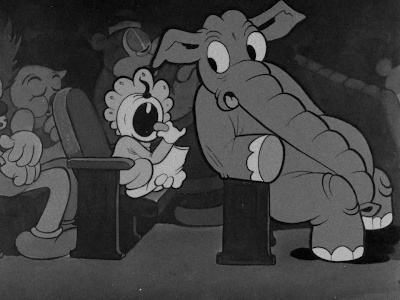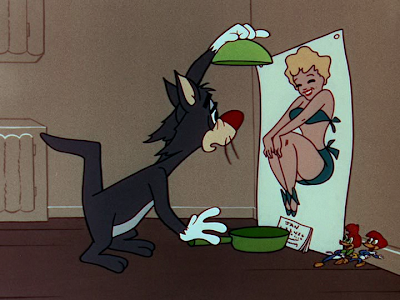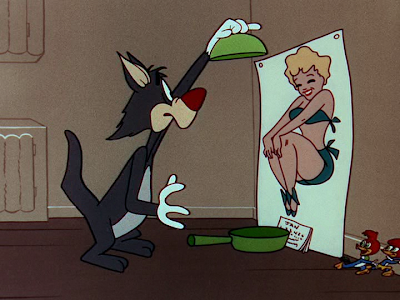.png)
.png)
.png)
.png)
.png)
.png)
This is from “Stopping the Show,” a 1932 Betty Boop cartoon where Mae Questel gets to show off her impersonation skills (which, I suspect, landed her a job with the Fleischer cartoon studio to begin with).
.png)
.png)
.png)
.png)
.png)
.png)
Sid Chatton, CKMX announcer an[d] impersonator of voices of screen and radio players, has joined Don Lee network.It piqued my interest because there couldn’t have been many impressionists on local Canadian radio at the time, and Chatton was among a string of people on Vancouver stations in the Golden Days of Radio to seek their fame on the other side of the border, including Arch Presby, Doug Gourlay, Fletcher Markle and the best-known of all, Alan Young. So I decided to dig a little further.
“Stars on Parade”By April, Chatton has moved to Los Angeles where he appeared at the Paramount Theatre, was tested for films and picked up whatever radio work he could. Then he got a big break. By 1938, he was picked to fill a vacancy on a trio called the Radio Rogues, who had begun to appear on independent stations in the New York City area in late 1931. Here’s a story in the Brooklyn Eagle from December 5, 1939 where they wave the local flag, even though Chatton was from Vancouver.
Reviewed Sunday, January 17, 4:15-4:30 p.m. Style—Talk. Sponsor—Kay Jewelry Company. Station—KPO and Coast NBC Red Network.
Except for the announcer (Grant Pollock) and the pianist who plays the theme, You Ought To Be in Pictures, this is a one-man show, but the man has many voices. He is Syd Chatton, 23-year-old imitator, late of the Canadian Broadcasting Company.
Idea of the show is the presentation of scenes from the current United Artist pictures, which Chatton doing a takeoff on the stars. This program was devoted to scenes from Charles Laughton’s Rembrandt, and all voices except female were Chatton’s. A novel note at the beginning was his simulation of the Coast’s well-known newscaster, Sam Hayes, to give the picture a plug. The announcer then gave a commercial and set the scene. Chatton did three scenes from the film, all with long Laughton speeches. Altho the lad’s imitation of the Laughton voice and vocal mannerisms were excellent, there was just too much. With no other known male star in the flicker, this could not be helped. A few lines of grade-A imitation is swell, but a quarter-hour makes the listener uncomfortable. More characters for Chatton to do would lend contrast and display a versatility which he had no chance to show on today’s offering.
Pollock read acceptable commercials in acceptable fashion, ending with the sponsor’s clever trade-mark, “It’s okeh to owe Kay.” P.K.
BROOKLYN BOYS MAKE GOODThe Radio Rogues also supplied voices for cartoons, but voice historian Keith Scott points out this was around 1934-35 before Chatton was with them.
By JANE CORBY
When somebody mentions the Radio Rogues, do you get a composite picture of Kate Smith, Adolf Hitler and Edward G. Robinson?
Me too.
The Radio Rogues, the great impersonators, are so darn well known as everybody else that I set out to track them down as just themselves—Eddie Bartell, Jimmy Hollywood and Sidney Chatton. big applause-getters of the much-applauded show “Hellzapoppin.” The best place to track down an actor—or three actors is in their dressing room just before a show. They’re bound to be there. They may elude you after the show, but not before. They may not want to be interviewed, but you sit in their dressing room where they've got to change within a few minutes and they will—if you're a feminine interviewer—talk. But fast. The show must go on and so must their costumes.
“Oops! Sorry.”
That was me, modestly backing out into the hall again after a glimpse of somebody in a costume that might have been a gym outfit and wasn’t. This sort of thing is bound to happen backstage at the Winter Garden, where the dressing room doors are always left open. Having backed into the hall and a passing actor, already in costume, including a brilliant tan like nothing that ever came out of Florida (oops! sorry, again), I was immediately recalled. One of the Rogues—it turned out to be Eddie Bartell—was now safe within a dressing gown; another, Jimmy Hollywood, was implacably in street attire; the third, Sid Chatton, was all ready for the first scene.
“Look,” I said, “which is which?”
“I sing,” said Eddie Bartell.
“I do the comedy,” said Jimmy Hollywood.
“I do dramatic stuff,” said Sid Chatton.
“Begin at the beginning,” I said. “You came from Brooklyn—where?”
“Flatbush,” said Eddie Bartell. “I went to Erasmus Hall.”
“I came from around DeKalb Ave.,” said Jimmy Hollywood. I went to school up the State Holy Cross.”
“I didn't come from Brooklyn,” said Sid Chatton, “I started in Canada.”
But he fixed that; he's a citizen now.
Why “Rogues”?
“When we started out on the radio we did impersonations, just as we do now,” said Jimmy. “We figured that what we were doing was stealing other people’s stuff, so we figured ‘Radio Rogues’ just about fitted us.” “We did impersonations on WLTH and other Brooklyn stations years ago,” said Eddie Bartell. “We did hill-billies and the Happiness Boys and Phil Cook and all the popular radio personalities.”
“We were,” said Jimmy Hollywood, “terrific.”
“We had an occasional spot on the air,” said Eddie Bartell. “One night we had to fill in for an act that could not appear. We decided to do imitations and the announced joined us. It happened that a booking agent heard us and overnight we turned professional, became the Radio Rogues.
“We’ve made a lot of picture, too,” said Jimmy Hollywood.
They’ve gone over big in pictures, continue to go over big on the radio and have been going over big in “Hellzapoppin,” a show which is in its second year and doing great. Have they any further ambitions?
“We want to buy a $1,500 fur coat,” said Sid Chatton, “we can take turned wearing it.”
The Rogues are all big Rogues—they’ll need a large coat. Eddie Bartell is the real athlete of the lot. He was the theatrical soft-ball star last year.
“The Hellzapoppin team played every show in town, in Central Park, wherever we could get a court. We played six shows and were undefeated.”
This year the soft-ball team is being reorganized and a hockey team too.
“This show’s a job for the next six months,” said Jimmy Hollywood. “Everybody figures, with their job safe, they might as well have some fun on their days off.”
The Radio Rogues were with “Hellzapoppin” before it became a Broadway show. It started as a half-hour vaudeville show, playing around the country six months before its hilarity brought it to Broadway.
But they were well used to success before the show came along. They had a “terrific time” in London in 1935, when they gave a request performance before King George V and the then Prince of Wales and Prince of York. Afterward they were entertained at Buckingham Palace.
Eddie Bartell’s career started far removed from the radio and theater. He was a salesman for a sporting goods house. Jimmy Hollywood was a Wall Street clerk and Sidney Chatton actually started in the theater, working with a brother of Johnson, of the "Hellzapoppin' " Olsen and Johnson, who present the show as well as act in it.
The pictures the Rogues have made including “Thanks a Million,” “Every Night at Eight” and “Going Hollywood.” They all like pictures. Sid wants to be a producer. He’s a walking encyclopedia of information on who played in what picture when.
All three Rogues live in California, Sidney Chatton in Hollywood, Jimmy Hollywood and Eddie Bartell in the San Fernando Valley, where many of the famous stars have homes, including Andy Devine and Louise Fazenda. Jimmy Hollywood has six children—three boys and three girls—and two of the youngsters, a boy and a girl, are already in pictures.
Syd Chatton of KTVU ( Channel 2) had a busy weekend in mid-March: From his “Pepito” show on Channel 2 he was seen in a KRON-TV 6 o'clock movie, then as a cop on a KP1X rerun of “San Francisco Beat,” then appeared live on KTVU again as staff announcer for a basketball telecast.Chatton died of a coronary on October 6, 1966 at Alta Bates Hospital in Berkeley. His Variety obit, California state records and even his gravestone claim he was 48 at the time of death. He wasn’t. And if you’re wondering why his name was variously spelled “Syd” and “Sid,” there’s a reason for that. It wasn’t his name.
.png)
.png)
.png)
.png)
.png)
.png)
.png)
.png)
.png)
.png)
.png)
.png)
.png)
.png)
.png)
.png)
.png)
.png)
.png)
.png)
.png)
.png)



Kid Series On Lawrence RosterSid Raymond was the voice of Katnip and Baby Huey, and eventually took over the role of the dopey Clifton Finnegan from Charlie Cantor on radio’s “Duffy’s Tavern.” Briefly in the '40s, he was also Heckle and Jeckle at Terrytoons. At the time he made “Toy Box Time,” he was touring in “Girl Crazy” with Harvey Lembeck and Al Lewis (I suspect they were probably funnier off stage than on). John Astin hadn’t broken out into television stardom yet; at this point, he was voicing commercials and doing theatre in New York. It appears this was Lawrence’s only New York-based foray into TV programming.
Robert Lawrence Animation, tele-commercial firm, is making its first move into programming with a pilot for a half-hour animated kid series with "strong adult appeal." Titled "Toy Box Time," the series will be in color and feature four individual story segments in each stanza. Original story, design and direction are by Cliff Roberts and George Cannata of the Lawrence staff. Original music is being composed by Rufus Smith with animation by Grim Natwick. Leading roles will be voiced by Sid Raymond, John Astin and Barbara Louis. Latter two are featured in the cast of the long running off-Broadway production of "Threepenny Opera."
Heritage Productions, N.Y., has begun work on Bobo the Hobo, 78 five-minute color cartoons to be available as five -minute cliff- hangers or 15-minute shows. Heritage's new location is 730 Fifth Ave. Telephone: Judson 6 -6500.The lineage of this one is a little unclear. A puppet series with the same name was produced (at $10,000 per 15-minute stanza) in 1952 by a company called Fantasy Features (Variety, Oct. 15, 1952). It starred the voice of Bret Morrison, better known as The Shadow on radio, and featured original songs by George Lessner. 26 episodes were made and passed through the hands of several different syndicators through the ‘50s. It was still in syndication when the cartoon series was proposed. Variety of August 5, 1959 reported Heritage had already finished making $210,000 worth of Bobo cartoons and a week later revealed Fremantle had sold them in Nigeria.
.png)
.png)
.png)
.png)
.png)
.png)
.png)
.png)
.png)
.png)
.png)
.png)
.png)
.png)